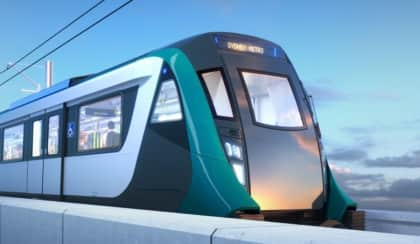Sydney’s Metro: All aboard the price rise train
It’s an age-old question: What’s the one silver bullet to instantly and consistently raise the price of property? Be in close proximity to a train station.

Given the public perception of housing near other transport nodes, particularly beneath flight paths, this line of thinking may be odd. But, according to new research released conjunctively by CBRE and PropTrack, suburbs impacted by Sydney’s metro line have performed markedly better than those lacking metro lines running through their borders.
The report titled Metro – Transforming Sydney Precincts found suburbs along the NSW capital’s metro line experienced a 49 per cent increase in capital value over the last decade, outperforming non-metro suburbs by an average of 5 per cent.
There is perhaps no clearer example of such starkly contrasting fortunes than a comparison of metro line suburb Castle Hill’s 72 per cent capital growth over the last decade and neighbouring non-metro suburb Baulkham Hills’ 49 per cent growth in the same period.
In a similar vein, metro line benefactor Crows Nest has seen property prices shoot up 79 per cent since 2013, compared to nearby Cammeray where the metro line doesn’t cut through, where they’ve climbed 62 per cent.
REA Group economist Anne Flaherty noted: “The enhanced accessibility provided by the metro, potential for additional infrastructure development, increased demand and possibilities for rezoning have all contributed to an overall increase in dwelling values.”
Dubbed Sydney’s “metro-fication” by CBRE’s Pacific head of research Sameer Chopra, growth as a result of this phenomenon isn’t limited to home values, with population growth, on average, 8 per cent higher in metro line suburbs than their neighbours.
Improved public transport options, and the convenience they bring, are expected to alter the Sydney living experience for those fortunate enough to live alongside these train lines. The proportion of people in the harbour city living in and around train lines has grown in recent years, with insights from KPMG indicating 49 per cent of the city’s new dwellings built between 2006 and 2021 were constructed within 1 kilometre of a train station.
Mr Chopra explained the benefits of metro-linked suburbs will become more widespread as Sydney ages.
“By 2030, Sydney will have a network of four metro lines, 46 stations, and 113 kilometres of new metro rail,” he said.
“We’ve already seen early evidence of this driving higher residential price growth and we see this outperformance increasing once the next stage is completed, with shorter commute times being a key driver.”
On average, commuters in metro-adjacent suburbs spend approximately 20 minutes less commuting each day as these routes increase the speed of service and severely slash travel times. This is evidenced by the marked decrease in the commute from Macquarie Park to Barangaroo, which will drop from 53 minutes to 19 minutes as a result of the metro’s opening.
An attractive feature of metro line suburbs is the potential for development within their borders, with modern design seeing high-end office and retail spaces enveloping metro stations.
All these factors have increased the appeal of these previously unheralded pockets of Australia’s most populated suburbs, particularly with younger generations, with the report finding 45 per cent of metro line residents are either Generation Z or Y.
The report deduced these suburbs’ popularity among younger generations is tied into the relative affordability and accessibility they offer city employees who can’t afford to live in the central business district but desire a more seamless, timely commute.
It also found these suburbs seem to have greater appeal to youthful generations due to their hospitality offerings, with metro line suburbs boasting, on average, 12 cafes per 10,000 residents and 23 liquor licences, as opposed to eight and 10 when comparing less dense suburbs.
Moving forward, CBRE’s data indicates demand for apartments in these regions, such as the Hills District, Lower North Shore, CBD and Canterbury-Bankstown region, is counteracted by lagging supply, particularly between 2020 and 2023. But the firm did forecast supply to rise in each of the next few years culminating in 11,500 apartments constructed in 2027, with a surge in development along the north-west corridor key to this surge.
